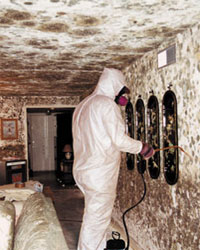Black Mold
If you’ve ever noticed a greenish-black looking patch of gelatinous material, often a bit slimy, but sometimes dry and powdery, growing in an area that has been, or continues to be, exposed to moisture, you just may have ventured upon an infestation of the infamous and extremely toxic black mold, known by its scientific names as Stachybotrys chartarum or Stachybotrys atra. This variety of fungus is sometimes found in the soil and in grains or plant debris, but it is more often found growing in cellulose-rich building materials in damp, humid, or flood-damaged buildings and water-soaked furnishings.
Stachybotrys chartarum was originally described in 1837, by August Carl Joseph Corda, a famous Czech mycologist (one who studies fungi) on the wall of a house in Prague, that was made up of wet gypsum material and damp wallpaper. Black mold can be found in many places around the world, but unlike some other mold species that can grow quickly or easily, black mold generally needs an environment containing lot of moisture over a long time period – at least a week or ten days – before it can begin to develop. That is why it is most commonly found where there has been a persistent and undetected water leak, such as inside a wall, behind ceiling panels, under floor boards, or in a house that has been open to the elements.
Black Mold Health Risks
While not all black-colored molds are dangerous to humans, Stachybotrys spores do carry trichothecene mycotoxins – poisons which can cause serious health problems in people and pets. Although toxic black mold can affect different people in different ways, it is most dangerous to children, the elderly and those with already compromised immune systems. Some of the symptoms of black mold exposure due to touching or inhaling the spore material include:
- Mental and neurological impairment – confusion, disorientation, dizziness, memory loss, numbness, seizures, etc.
- Respiratory ailments – coughing, shortness of breath, swelling of or bleeding in the lungs, sore throat, runny, itchy or stuffy nose, etc.
- Circulatory problems – heart inflammation, decreased blood pressure, internal hemorrhage, bleeding in the brain or other organs, etc.
- Severe eye irritation – blurred vision, jaundice, soreness and irritation, etc.
- Immune system deficiencies – reoccurring infections, etc.
- Reproductive system problems – infertility, impotence, miscarriage, fetal abnormalities.
- Fatigue and general discomfort – muscle soreness, weakness, aches and pains, nausea, headaches, diarrhea, vomiting, joint pain, etc.
- Damage to internal organs – hair loss, weight loss, liver disease, coma.
- Death
While some of these symptoms may disappear once a person is no longer exposed to toxic black mold, there is no antidote for the harm it can do, and some of the health problems it causes can remain permanent. That is why it is important, if black mold is suspected, you remove yourself from the environment and arrange to have it eradicated as quickly as possible. And the only way to tell for sure that the discovered fungus is toxic black mold is to have a sample identified by an expert, under a microscope.
Removing Black Mold
If you must attempt to remove black mold by yourself, be sure to wear protective gloves, eye goggles, clothing that completely covers you, and a respiratory device that will protect you against unintended inhalation of the black mold spores. Brushing a small area of black mold with a solution of Borax and water can be effective on porous surfaces such as wood and fabric, and a household detergent mixed with water can be used on nonporous surfaces such as glass and tile. Ammonia, hydrogen peroxide, tea tree oil, white vinegar, baking soda and household bleach can also be applied to nonporous surfaces.
But if you do discover an extensive amount of toxic black mold in your home, for example, one that is scattered in areas greater than a ten-foot square section, you should really not attempt to remove it by yourself. Disturbing Stachybotrys mold can cause it to release large amounts of mycotoxin-containing spores throughout the environment, contaminating the rest of your home. It’s much safer to call a professional and consider moving to temporary accommodations until the removal is accomplished.
Also, it is just as important to completely inspect your house to determine the extent of the infestation, as well as the moisture problem that allowed the mold to propagate in the first place. Professional mold inspectors have the expertise and the tools, such as moisture meters and fiber optic cameras that can find hidden mold colonies in normally undetectable places. Areas to closely check include those that suggest moisture damage – warped walls and peeling paint, for example – as well as spaces near water pipes or where high humidity is prevalent, such as laundry rooms and damp basements.
Black Mold is Persistent Danger
While it is possible to remove toxic black mold, the mycotoxins that Stachybotrys releases are very resilient and can take years to break down naturally. Some experts believe that they are so small – as little as 0.1 microns across – they can never be completely removed from a house that has been contaminated. In the most severe infestations, there are reports that some homeowners have had to move out of their homes permanently.
So if you suspect black mold by smell or visual identification, don’t delay. Have a professional determine the mold’s variety and potential toxicity as soon as possible. Then, if it is toxic black mold, arrange to have it removed and the area remediated. Living with toxic black mold is a health risk simply not worth taking.
